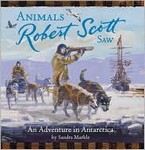Through the Looking Glass Children's Book Reviews
Animals Robert Scott Saw: An Adventure in Antarctica
Nonfiction Series
For ages 7 to 10
Chronicle Books, 2008 ISBN: 081184918X
For hundreds of years, humans had no idea that Antarctica existed. Then hunters seeking whales and seals became interested in the southern continent. They were soon followed by explorers who wanted to know what the ‘new’ continent was like. They not only wanted to explore the interior of the land, but some of them also dreamed of becoming the first human to reach the South Pole.
In July of 1901, a ship called the Discovery set sail from Scotland for the Antarctic. Robert Falcon Scott was the expedition leader, and his mission was to learn as much as he could about the Antarctic and to get to the South Pole. After taking on the sled dogs that were waiting for them in New Zealand, the explorers headed south. The men on the Discovery saw bird species they had never seen before, including penguins and fulmars.
By the time they got to Antarctica’s coast, winter was on its way. The sea froze over, and the Discovery was locked in place by the ice. The explorers would have to wait for the short polar summer to arrive before they would be able to go anywhere. Wearing clothes made out of wolfskin, sheepskin, and reindeer hide, the expedition members did their best to keep busy during the long, cold, and dark winter months. The expedition biologist spent much of his time collecting specimens of sea creatures, many of which were new to science.
This fascinating story describes the two expeditions that Robert Scott made to the Antarctic in a new way. Instead of just looking at the humans in the story, the author looks at the animals that Robert Scott and his men saw, and the effect that some animals had on the expedition as a whole. For example many people believe that Scott’s second expedition might have been successful if he and his men had learned how to use sled dogs to better effect.
The interesting text is complimented throughout the book by beautiful illustrations, period photographs, and text boxes containing supplemental information. This is one in a series of books about explorers and explorations.




